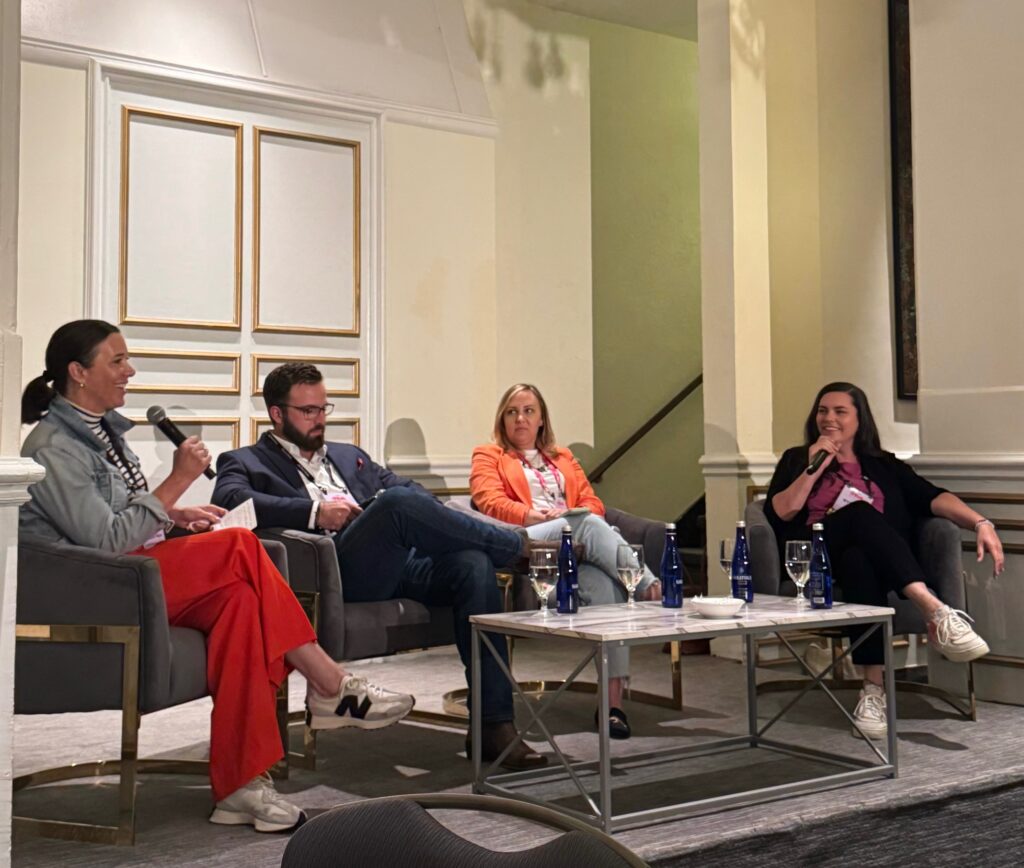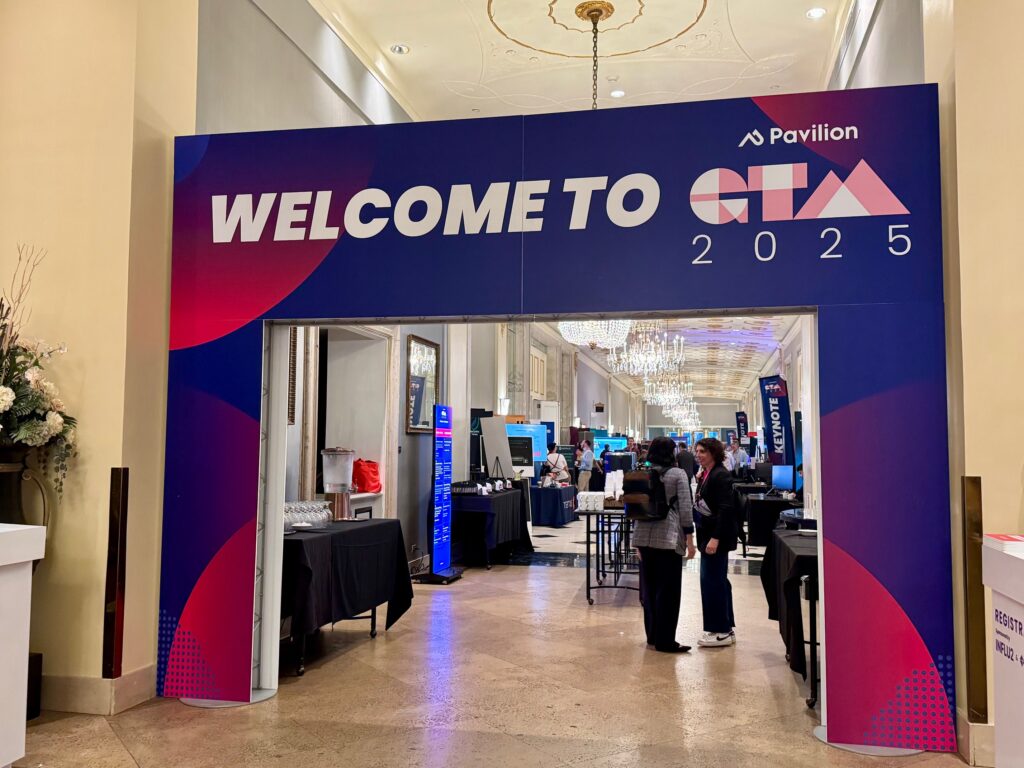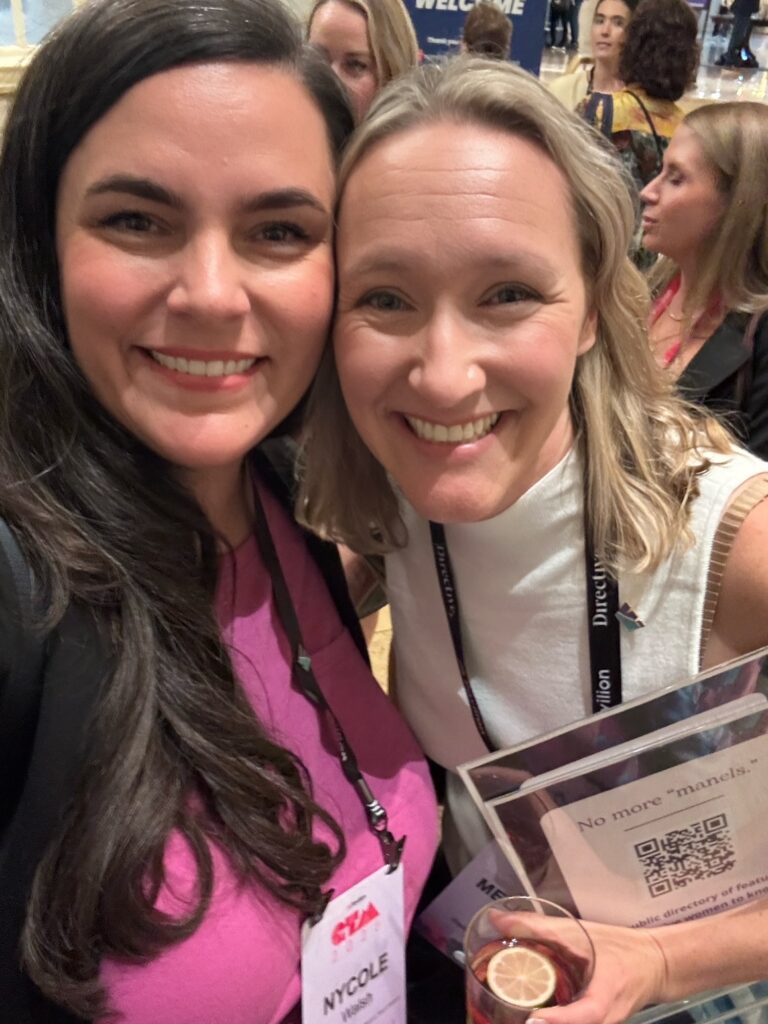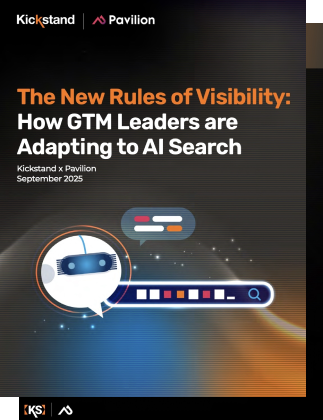
by Nycole Walsh
A Capital Week for Go-to-Market Leaders
Washington, D.C. was buzzing last week as Pavilion hosted its largest event of the year: GTM2025. Between the marble monuments and the early-fall skyline, the city set the stage for a conference that felt equal parts strategy summit and reunion of B2B’s sharpest operators. From packed keynotes to late-night hallway introductions, the energy was palpable; in these rooms, you could really get a glimpse at where GTM is headed next.
For Kickstand, it was an especially meaningful trip. Molly and I came to listen, to learn, and to share a perspective of our own — on stage and off.
Our Panel: AI Search Visibility in the Real World
A major highlight was moderating my first-ever conference panel, joined by Amanda McGuckin Hager (CMO & CRO, True Dialog), Colby Proffitt (CMO, Carbyne), and Jane Serra (VP Growth Marketing, Daxtra; creator and host of Women in B2B Marketing).

From left to right: Amanda McGuckin Hager, Colby Proffitt, Jane Serra, Nycole Walsh
Together we dug into how AI-powered search and large language models (LLMs) are rewriting the rules of brand visibility — and how GTM leaders are adjusting in real time. Drawing on early insights from a new study Kickstand conducted in partnership with Pavilion, we compared notes on the chaos created as traditional search performance shifts, the internal pressure from boards and executives to explain falling site traffic, and the creative early experiments teams are testing: from LLM-friendly sitemaps and FAQ schemas to first-party research and smart use of review sites like G2 and Gartner Peer Insights.
A huge thank-you to Amanda, Colby, and Jane for spending the time with us and for being willing to speak so frankly about a topic we’re all still figuring out together. Rather than attempt a full blow-by-blow recap here, I’ll leave the deeper dive to the session recording, which Pavilion will post soon — we’ll be sure to share it once it’s available.
The Sessions and Ideas That Stuck

The calm before the storm
1) Building the AI-Powered Marketing Org of the Future — Kathleen Booth (Pavilion), Liza Adams (GrowthPath Partners), and Evelyn Swaim (Seismic)
This session was so packed they were literally turning people away, and it delivered on the hype. Booth, Adams, and Swaim went deep on how to redesign a marketing organization when AI is part of every workflow. They warned against chasing an assortment of shiny tools — what one attendee at the Women’s Summit jokingly called an “island of misfit toys” — and urged leaders to treat AI as a means to efficient growth. Mega super duper bonus points to the Star Wars fan who created the presentation slides. I fangirled, obviously.
2) Agentic AI and the Next Wave of Automation — multiple sessions
Across several discussions, speakers explored the rise of agentic AI, where autonomous agents not only complete tasks but interact with each other. One memorable example came from Amanda Kahlow of 1mind, who described a future in which AI sales avatars could negotiate directly with AI procurement agents on the buying side. The implication: tomorrow’s GTM playbooks will need to account for machine-to-machine conversations as part of the buyer journey.
3) AI v. Human: A No-Holds Barred Debate on the Future Role of AI in GTM — Patricia DuChene (Sendoso), Amanda Kahlow (1mind), Toby Carrington (Seismic)
Those same conversations raised the possibility that AI will push companies toward outcomes-based pricing. Rather than charging per seat, imagine a model where customers pay according to the revenue AI agents help generate. As speakers in this lively session pointed out, it’s a win–win: if an AI solution is driving millions in incremental revenue, even a high annual fee looks like a bargain.
4) Brand’s Return to Center Stage — echoed throughout GTM2025
While AI dominated the agenda, many presenters emphasized that brand is once again table stakes (after a recent period of notable deprioritization). Companies that invested in brand earlier and/or more consistently are now reaping the benefits, while those that put it off are scrambling to catch up. In a world where AI can drive the marginal cost of content toward zero, a trusted and memorable brand remains one of the few differentiators no algorithm can replicate.
5) Wednesday Women “Ripple Toast” — celebrating growth and community
The third annual Ripple Toast, hosted by the Wednesday Women community, began back at the very first GTM event in 2023 as a small circle of women leaders. This year, it had grown so much it needed an entire ballroom. Seeing those ripples of connection and support widen year after year was both inspiring and humbling, and a powerful reminder of how community can scale impact far beyond a single conference.
6) Unreasonable Hospitality (But Make it GTM) — keynote by Will Guidara
Guidara challenged every attendee to re-engineer customer touchpoints — especially the awkward or transactional moments — into opportunities for surprise and delight. He recounted how his restaurant transformed the dreaded arrival of the check into a celebratory experience, proving that unforgettable moments don’t require deep pockets, only intentional design.
Women’s Summit Moments We’re Still Thinking About
Childhood praise as a map to adult superpowers
Brandi Starr offered one of the most thought-provoking prompts of the day: look back at the compliments — and even the critiques — you heard as a child and treat them as clues to your hidden strengths. She shared how teachers once scolded her for talking too much in class, only to realize later that the very skill behind those “talks too much” notes — clear, confident communication — became her professional superpower. The room buzzed as attendees swapped their own stories, many recognizing that what once felt like a flaw has shaped the leadership qualities they rely on today.
Annual planning and the three A’s
Another standout session reframed the annual planning process around three deceptively simple questions: Alignment, Anticipation, and Accountability. Are the right people and priorities aligned? Have you anticipated different scenarios and mapped “if-then” responses? And does everyone know who owns what once the plan is in motion? Rachel Nazhand (Zelis) underscored that a plan is never a prophecy, but rather a navigation system for what actually unfolds. One practical tip that resonated: if you want an idea to stick, recruit a second executive champion early to help secure buy-in.
An atmosphere built for real talk
Perhaps the most enduring impression came not from a single slide or quote but from the room itself. Pavilion’s Women’s Summit created a space where senior leaders spoke with unusual candor — sharing both the challenges of leading through rapid change and the personal strategies that keep them grounded. It was high-signal and refreshingly ego-free, a reminder that leadership development isn’t just about frameworks or KPIs; it’s about finding and supporting your people.

Me and Melissa Moody of Wednesday Women, Ripple Toast remnants still in hand
My Favorite Moments
One of the most humbling experiences came not from the stage but from countless hallway conversations. Over and over, people I admire — many of them B2B leaders I’ve looked up to for years — told me they already knew the Kickstand name. Hearing that our work is recognized beyond our own network was deeply gratifying. It’s one thing to talk about building brand visibility for our clients; it’s another to feel the impact of that visibility for ourselves.
Another milestone was personal: moderating that conference panel! Taking the stage alongside seasoned CMOs and growth leaders, guiding a conversation that felt both candid and insightful, was a professional bucket-list item I’d been eager to check off. Walking off stage, I couldn’t help but feel proud of how naturally the discussion flowed and how engaged the audience remained throughout.
And because no one can catch everything at an event this packed, I’m grateful Pavilion recorded every session. Even after a week of networking and note-taking, I know I’ve only scratched the surface. Next weekend is already earmarked for a self-styled “GTM Part 2,” where I’ll revisit the recordings, dig into the sessions I missed, and keep the learning going long after the conference lights have dimmed.
Looking Ahead: Our AI Search Visibility Research Drops October 7th

As inspiring as GTM2025 was, the conversations in D.C. were really just the starting line. The themes that kept surfacing — AI’s impact on discoverability, the scramble to rethink metrics, the urgency of brand — are exactly what our own research has been exploring for the past several months.
On Monday, October 7th, we’ll release the findings from our latest study on AI search visibility — a project designed to answer the questions marketing leaders were asking in nearly every hallway chat last week. Among the insights:
- Which two strategy changes more than double the likelihood of generating meaningful leads from AI-driven search
- The new metrics CMOs are adding to their dashboards to measure AI search impact
- And, with so many options to test, the specific tactics leaders are prioritizing first to stay visible in a rapidly shifting landscape
If GTM2025 was a glimpse of the future, this research is the data-backed roadmap for how to meet it.
Follow Kickstand on LinkedIn or subscribe to our Content Hub so you’re first to know when the full report goes live. We’ll share the numbers, the stories behind them, and practical steps you can take right away to capture (and keep) your place in the age of AI search.



